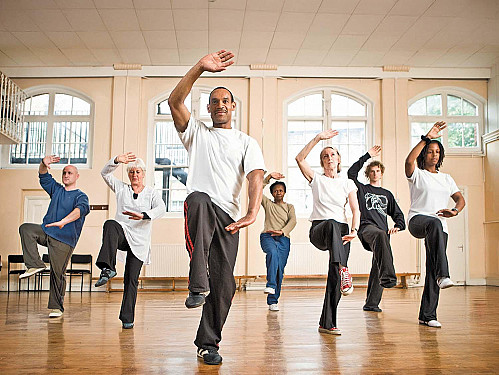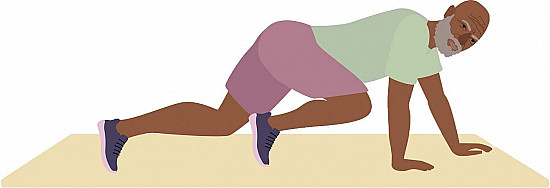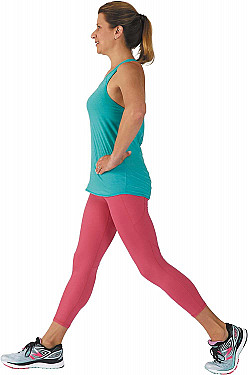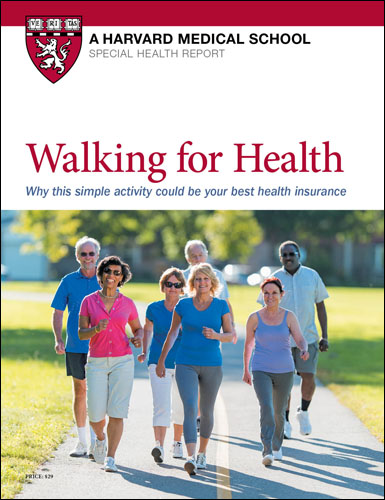Get more out of your daily walk
Incorporate balance exercises, weight training, and vigorous activity into your routine.
- Reviewed by Anthony L. Komaroff, MD, Editor in Chief, Harvard Health Letter; Editorial Advisory Board Member, Harvard Health Publishing

You already go for a walk every day, which is great for overall health. Regular, brisk walking helps lower LDL (bad) cholesterol, control blood pressure, strengthen muscles, burn calories, and lift mood. Walking can also help ward off high blood pressure, heart disease, stroke, and diabetes.
And you can get even more health benefits by adding a few simple upgrades to your daily walk.
Improve your balance
Your sense of balance is based in the brain. "The brain integrates information from your inner ear organs, vision, and nerve endings and feelings in the feet, muscles, and joints, all the way up the spine," says Dr. Steven Rauch, medical director of the Balance and Vestibular Center at Harvard-affiliated Massachusetts Eye and Ear.
To maintain good balance, you need to put it to work regularly. Taking a daily brisk walk is good practice. If walking is easy for you, Dr. Rauch suggests making it a little harder, to get even more practice and potentially get better at balancing. For example, during a walk you could periodically take about 10 steps walking heel-to-toe. "The narrower your base of support when standing, the trickier it is to maintain your balance," Dr. Rauch says.
Other ideas: Turn sideways and take 10 side steps. Or keep walking forward, but turn your head slowly left and then right, a few times in a row. Why? "If you're walking in a certain direction but turn and look in a different direction, or aim your ears in a different direction, you're not giving the usual visual or auditory feedback to the brain, and it challenges your balance," Dr. Rauch says.
Promote healthy bones and muscles
The more gentle stress we place on our bones, the stronger they'll become. The reason: exerting force on the bones stimulates them to add cells, which speeds up the process of building bone mass. Weight-bearing exercise is a standard way to strengthen your bones, and walking is a weight-bearing activity. Weight lifting is also a good way to strengthen bones. You can combine the two activities for extra oomph by wearing a weighted vest on your walk.
Get one that allows you to adjust the amount of weight you'll carry, such as a vest that has removable weights. You can find them for about $40 or more online or at sporting goods stores. How much weight should you carry in the vest? "Start with 5 pounds. After two weeks, increase the weight to 7.5 pounds. Two weeks, later, move up to 10 pounds. But don't wear the vest if it makes it hard to walk or if you experience any pain or soreness after wearing it," suggests Vijay Daryanani, a physical therapist at Harvard-affiliated Spaulding Rehabilitation Hospital.
Make your heart work harder
Walking at a brisk pace is a moderate-intensity activity that makes your heart and lungs work harder. The exertion activates changes in your muscles, metabolism, blood vessels, and brain that contribute to improved heart health.
Your heart and lungs work even harder (and get even more benefit) with vigorous activity — the kind that makes it difficult to talk while working out, such as playing tennis or jogging. But check with your doctor before starting a program of vigorous activity.
One way to make your heart work harder on a walk is by adding arm movements. About 10 minutes into a 30-minute walk, begin raising your arms up and down repeatedly in any way that feels comfortable — such as straight out in front of you (like a sleepwalker in old movies), above your head (like a referee signaling a touchdown), or out to the sides (like you're flying). Try to maintain the arm activity as long as possible, up to 10 minutes. Then continue your walk for another 10 minutes.
Another way to make your heart work harder on your walk is by adding high-intensity interval training (HIIT). HIIT involves brief bouts of strenuous exercise. It's associated with equal or greater improvements in blood pressure and blood sugar compared with moderate-intensity exercise. But, again, check with your doctor.
During a walk, that would mean periodically breaking into a run for about 30 to 60 seconds. The easier this becomes, the longer the high-intensity intervals can last. Eventually, you may be able to walk for five minutes, then run for five minutes, alternating the activities for about 30 minutes.
Image: © MixMedia/Getty Images
About the Author

Heidi Godman, Executive Editor, Harvard Health Letter
About the Reviewer

Anthony L. Komaroff, MD, Editor in Chief, Harvard Health Letter; Editorial Advisory Board Member, Harvard Health Publishing
Disclaimer:
As a service to our readers, Harvard Health Publishing provides access to our library of archived content. Please note the date of last review or update on all articles.
No content on this site, regardless of date, should ever be used as a substitute for direct medical advice from your doctor or other qualified clinician.
















